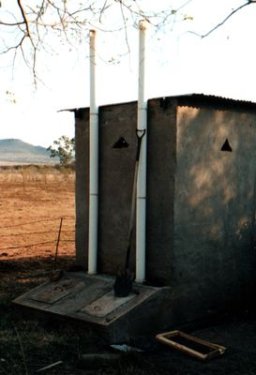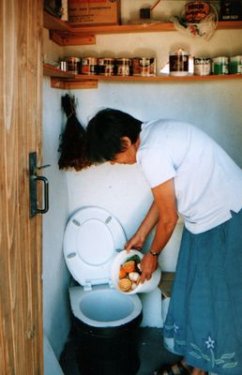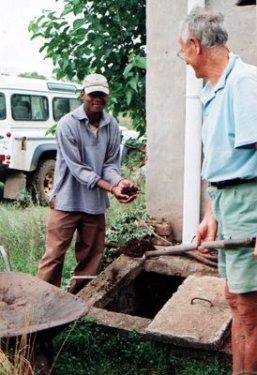| "Apology: To some of my friends who read this and are farmers. I imply no criticisms of or judgements on their farming methods and beg their forgiveness if anything I say is taken amiss. They are operating in this sad real world and have to comply with the New Economic (dis)Order and, with things as they are, they can do little else if they are to survive." |
|
MICROFARMS AND SUSTAINABILITY
How does the Microfarm compare in its use of non-renewable resources and waste disposal, with the Big Hectare Farmers (BHFs)?
- Fossil fuel use:
1. Field operations on the microfarm mostly use manual labour while fixed operations like pumping from a hafir can use solar power. Compare the BHFs with their mammoth field machinery, powerful pump-sets for overhead irrigation and their mega-dairies, piggeries and chicken factories
2. The microfarmer markets most produce at or near the farm gate requiring minimal transport and refrigeration, while huge trucks (some refrigerated) carry the BHFs' produce to processing plants, distribution centres and those supermarkets surrounded by their prairies of car parks
3. Soil fertility maintenance: microfarmers are scavengers. From cowpats to kerbside black bags of garden rubbish, they scoop it up and convert it to soil fertility. The most advanced ones even have the best re-cycler of all - the compost toilet. No organic "waste" is safe when a microfarmer is around with a bucket, wheelbarrow, cart or van.
The BHFs meanwhile depend on synthetic fertilizers, N, P and K.
N requires energy for its manufacture - the power-hungry Haber-Bosch process; P and K require energy for their mining, milling, beneficiation and (for P) transport half way round the world.
- Finite Resources:
1. Peak Oil and Peak Gas are coming if not already here: tough for the BHFs
2. Peak Phosphate - yes! - is coming soon: tough for the BHFs
3. Water: industry will always be able to out-bid even the BHFs for water, until those supermarket shelves are empty. But no one can steal the water from a microfarmer's hafir!
- Waste disposal:
Visit a BHF and what do you see? Yards littered with defunct and rusting machinery; plastic silage wrap (they have to pay good money now for it to be taken away); empty packaging.
Worse, what do you smell? Slurry tanks, effluent lagoons and their ammonia-rich aromas. With the new climate dispensation, heavy rain can overwhelm these any time and poison a river.
The microfarmer, though, jealously guards all excreta as the best soil or compost additive. None should escape the farm, even the urine of kraaled animals.
As for packaging, selling at or near the farm gate it can be re-used many times if handled carefully.
- Land Degradation:
Soil is not an inert, passive medium in which crops are grown. It is full of life, some of the products of which are the "glue" that binds soil particles together into the small aggregates that we call "crumbs". Without this aggregation, soil would be mud when wet and dust or concrete when dry - impossible to make a seed-bed in and impervious to rain and the air needed by roots (when wet). Further, this crumb structure is fragile: drive (or even walk) over wet soil and these crumbs are smeared and squashed out of existence, leaving tyre tracks (and even footprints) to become mud or concrete. More sinister is the effect of mechanical cultivation because in addition to the tyre tracks, these crumbs are smashed out of existence. But weeds are controlled, the eye is pleased. Meanwhile, the crumbs are destroyed, the wind blows and the rain washes the soil away. Moreover, it is the finest fraction of the soil (clay and particles of organic matter) that goes first. These are the surface-active particles (micelles) to which the otherwise-soluble plant nutrients stick, so preventing their leaching by any amount of rain. Without them, rain or irrigation water will simply wash any fertility there may be in the soil down into the ground water, out of reach of crop roots.
Microfarms, with their square metres of crops can confine their human operators to small paths amongst the crops so their soil may never need to be trodden on! And after those heavy applications of organic material, even the heaviest rains sink into the soil where they fall.
But observe the standing water on the arable lands of the BHFs after even quite small amounts of rain and then see the soil actually beginning to move downhill leaving the higher ground impoverished and crop plants buried on the lower. And if it doesn't rain, see the dust clouds following every movement of tractor or vehicle.
| |

Compost toilet, back view; 2 sections each with ventilator (aerobic process of course) and hatch for adding extra biomass if necessary and for removal of contents later

Compost toilet - also for disposal of kitchen waste

Compost toilet, removing - and admiring - the product
|
|
|